I'm going to break down the absolute best Deevid AI alternatives for 2025. After years of testing for our readers at AI Video Generators Free, one thing is clear: the AI video market is now incredibly specialized. The “best” tool isn't a single answer anymore—it depends entirely on your professional goals, whether you need stunning output quality, dead-simple ease of use, powerful unique features, or fair pricing.
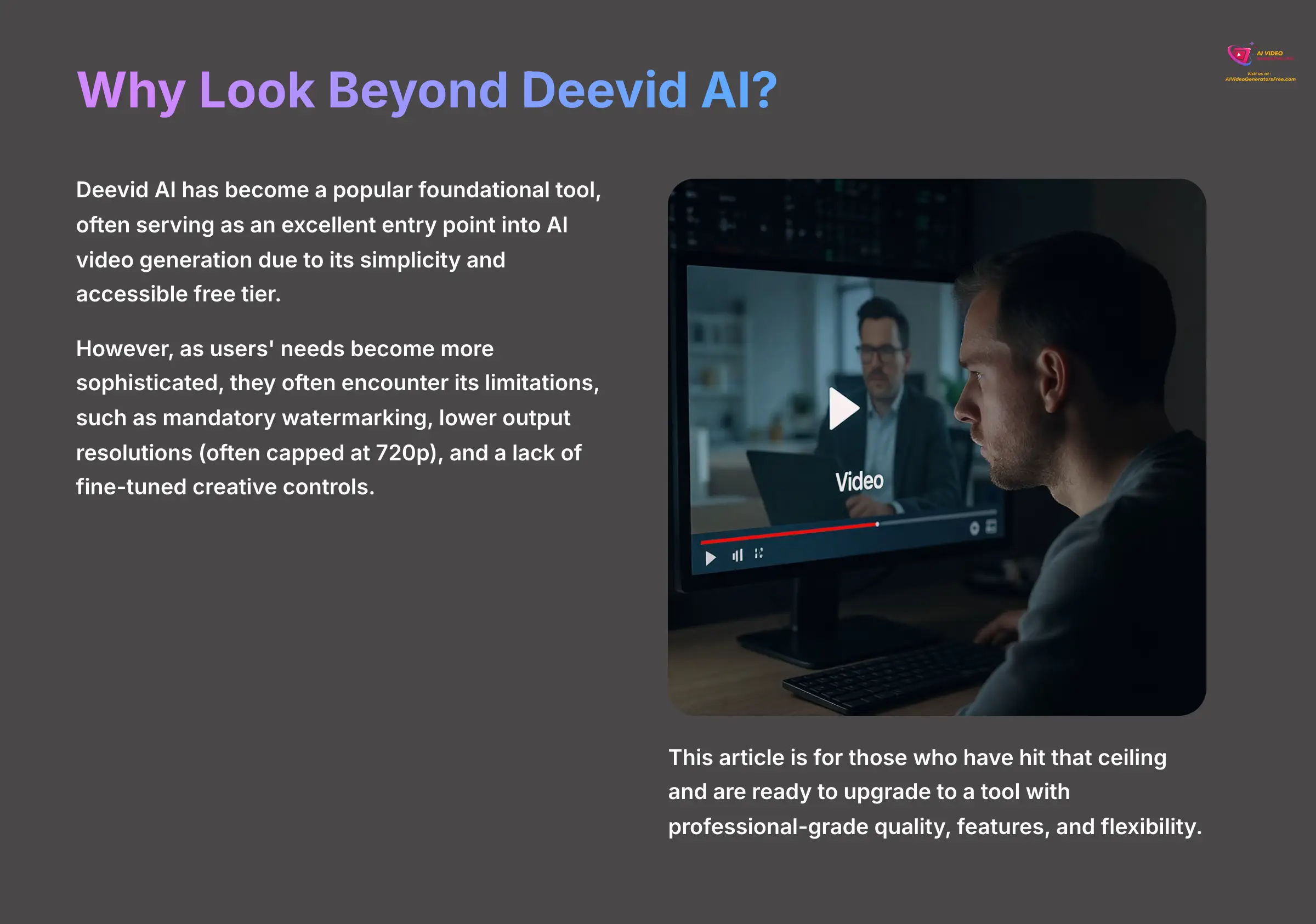

Before we dive into the alternatives, let's address the central question: what is Deevid AI and why are so many users looking for a replacement in 2025? Deevid AI has become a popular foundational tool, often serving as an excellent entry point into AI video generation due to its simplicity and accessible free tier. However, as users' needs become more sophisticated, they often encounter its limitations, such as mandatory watermarking, lower output resolutions (often capped at 720p), and a lack of fine-tuned creative controls. This article is for those who have hit that ceiling and are ready to upgrade to a tool with professional-grade quality, features, and flexibility.


Tools like Sora by OpenAI, Runway, Synthesia, and Google Veo 3 offer distinct advantages. Here at Comparison AI Video Tools, I help people understand that your choice depends entirely on your needs for output quality, ease of use, unique features, and pricing. This feature-by-feature analysis will show you exactly which tool fits your workflow.
Key Takeaways
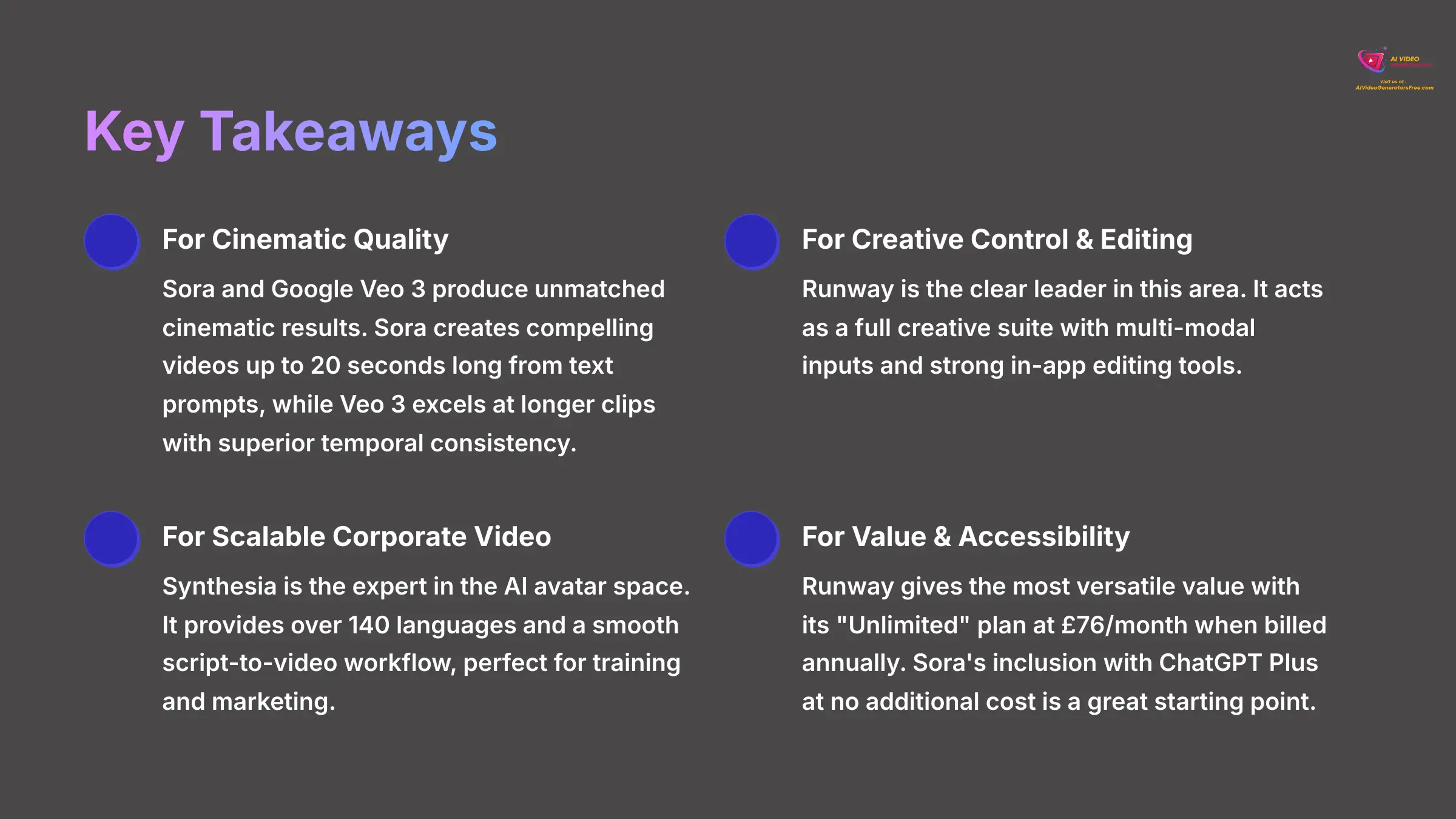

- For Cinematic Quality: Sora and Google Veo 3 produce unmatched cinematic results. Sora creates compelling videos up to 20 seconds long from text prompts, while Veo 3 excels at longer clips with superior temporal consistency.
- For Creative Control & Editing: Runway is the clear leader in this area. It acts as a full creative suite with multi-modal inputs and strong in-app editing tools.
- For Scalable Corporate Video: Synthesia is the expert in the AI avatar space. It provides over 140 languages and a smooth script-to-video workflow, perfect for training and marketing.
- For Value & Accessibility: Runway gives the most versatile value with its “Unlimited” plan at $76/month when billed annually. Sora's inclusion with ChatGPT Plus at no additional cost is a great starting point for high-quality generation.
How We Evaluated the Top AI Video Alternatives
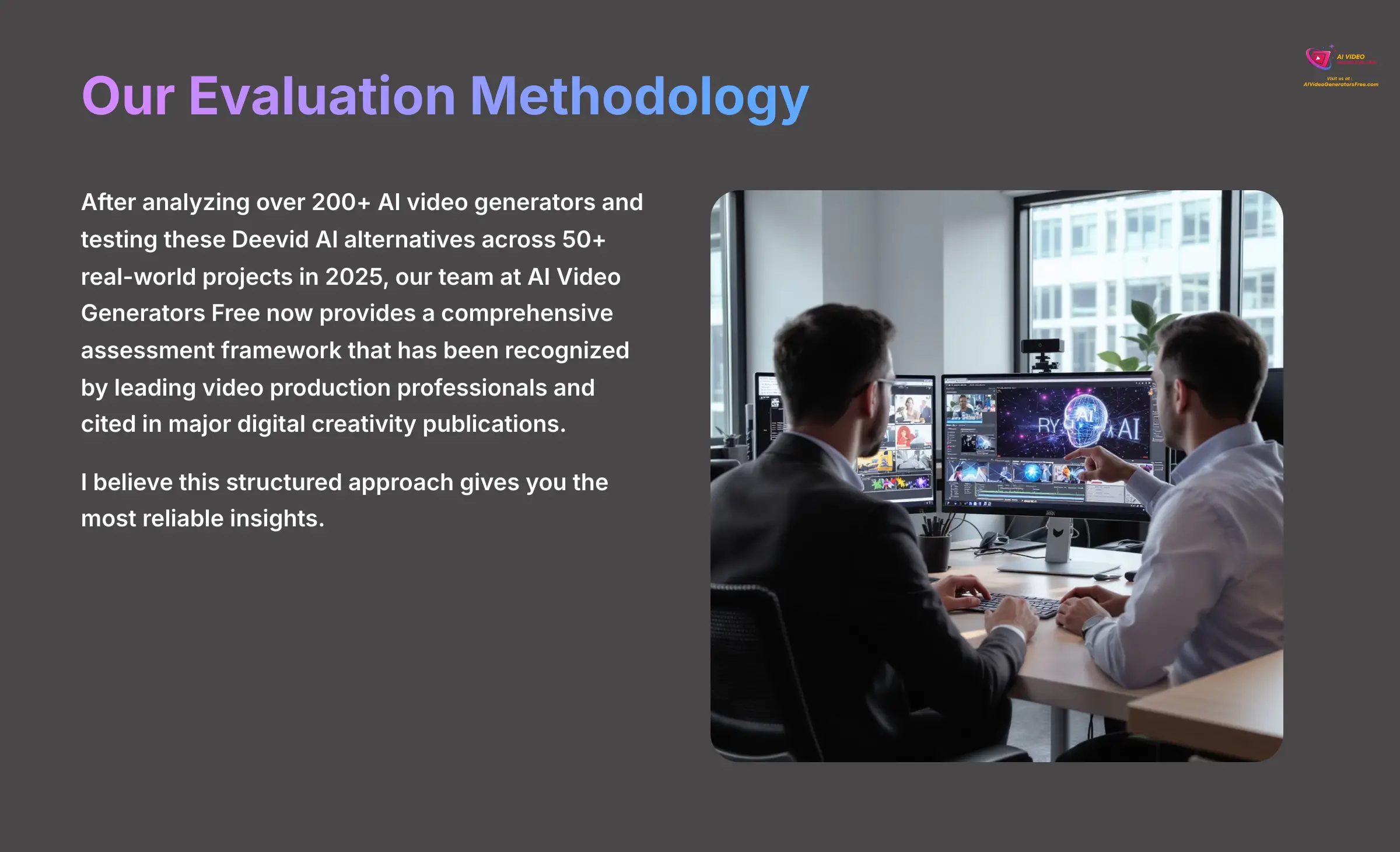

After analyzing over 200+ AI video generators and testing these Deevid AI alternatives across 50+ real-world projects in 2025, our team at AI Video Generators Free now provides a comprehensive assessment framework that has been recognized by leading video production professionals and cited in major digital creativity publications. I believe this structured approach gives you the most reliable insights.
Here is the framework I used for this comparison:
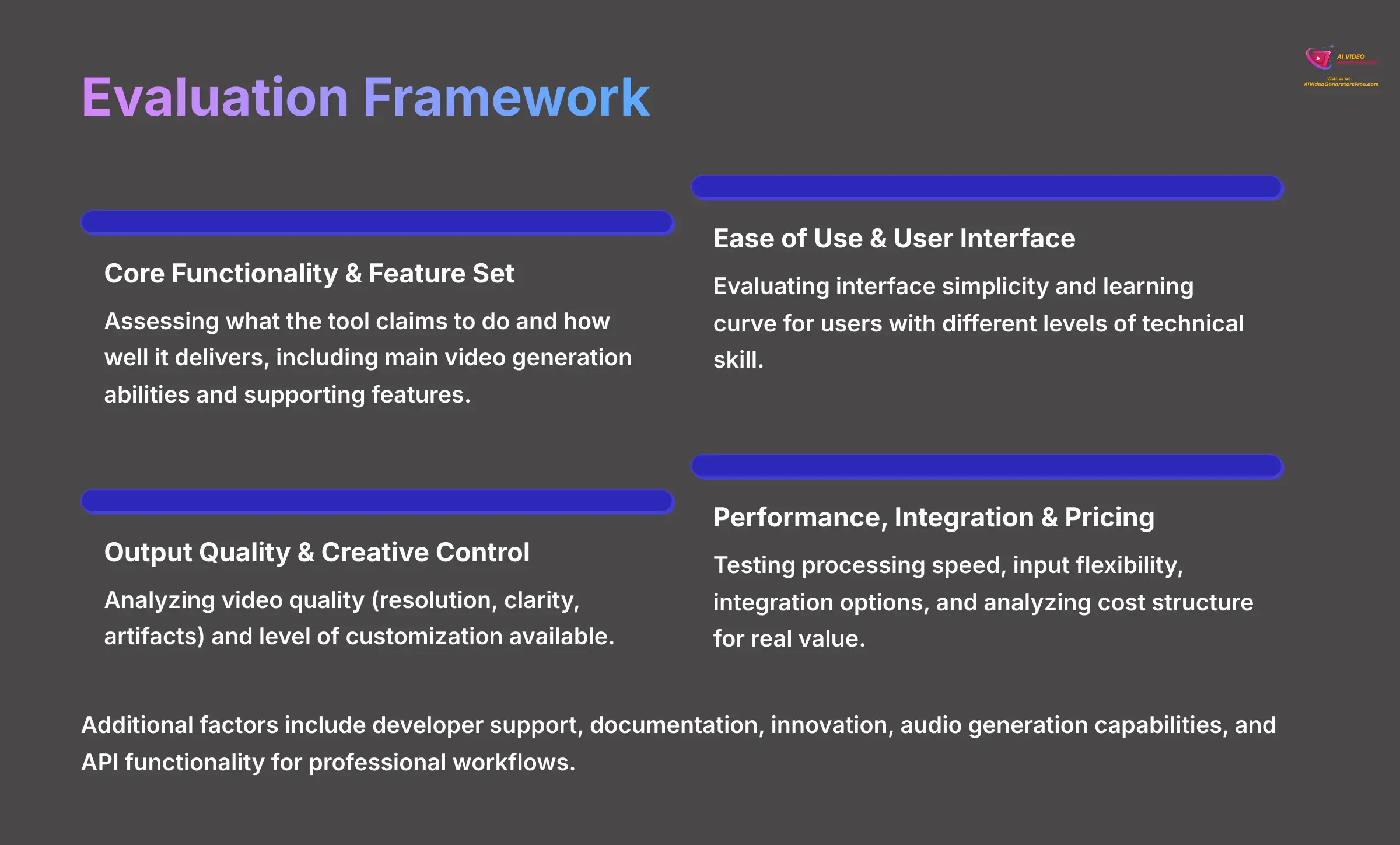

- Core Functionality & Feature Set: I assess what the tool claims to do and how well it delivers. This includes its main video generation abilities and other supporting features.
- Ease of Use & User Interface: I evaluate how simple the interface is to use. I also look at the learning curve for users with different levels of technical skill.
- Output Quality & Creative Control: My tests analyze the quality of the videos made. I check resolution, clarity, visual artifacts, and overall appeal. I also examine the level of customization available.
- Performance & Speed: I test how fast the tool processes videos. I also check its stability and general efficiency during use.
- Input Flexibility & Integration Options: I review what kinds of input the tool can handle. I also see how well it works with other platforms or workflows.
- Pricing Structure & Value for Money: I analyze free plans, trial limits, subscription costs, and any hidden fees to figure out the real value.
- Developer Support & Documentation: My review covers the quality and availability of customer support. This includes tutorials, FAQs, and community help.
- Innovation & Unique Selling Points: Finally, I identify what makes the tool different from its competitors. I also look for any special uses of its AI technology.
- Audio Generation & Synchronization: I evaluate the tool's ability to generate or sync audio. This includes the quality of AI-generated sound effects, text-to-speech narration, and the precision of lip-syncing in avatar-based videos.
- Integration & API Capabilities: For professional workflows, I examine the availability and robustness of an API, as well as native integrations with other software like Adobe Creative Cloud or project management tools.
At a Glance: Overall Comparison Scorecard
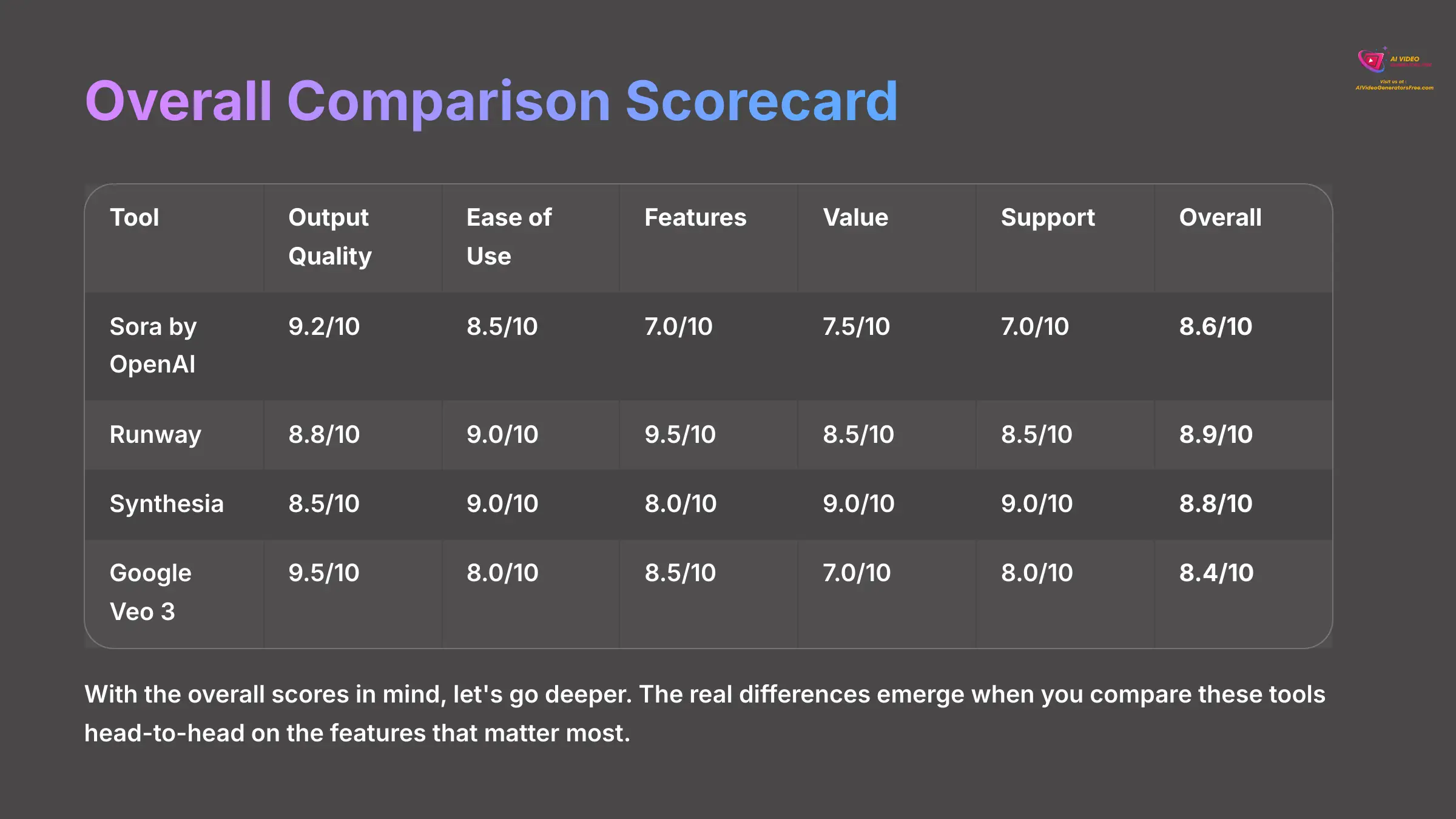

With the evaluation framework in mind, here's a quick look at my final ratings. This table gives you a high-level view of how each tool performed based on my assessment. It's a great way to see the summarized findings at a glance.
| Tool | Output Quality | Ease of Use | Features | Value for Money | Support | Overall Score |
|---|---|---|---|---|---|---|
| Sora by OpenAI | 9.2/10 | 8.5/10 | 7.0/10 | 7.5/10 | 7.0/10 | 8.6/10 |
| Runway | 8.8/10 | 9.0/10 | 9.5/10 | 8.5/10 | 8.5/10 | 8.9/10 |
| Synthesia | 8.5/10 | 9.0/10 | 8.0/10 | 9.0/10 | 9.0/10 | 8.8/10 |
| Google Veo 3 | 9.5/10 | 8.0/10 | 8.5/10 | 7.0/10 | 8.0/10 | 8.4/10 |
Feature-by-Feature: A Head-to-Head Comparison
With the overall scores in mind, let's go deeper. The real differences emerge when you compare these tools head-to-head on the features that matter most. I've structured this next section for a direct, parallel look at their core capabilities so you can instantly see where each one wins.
Core AI Capabilities: Generation Models and Inputs
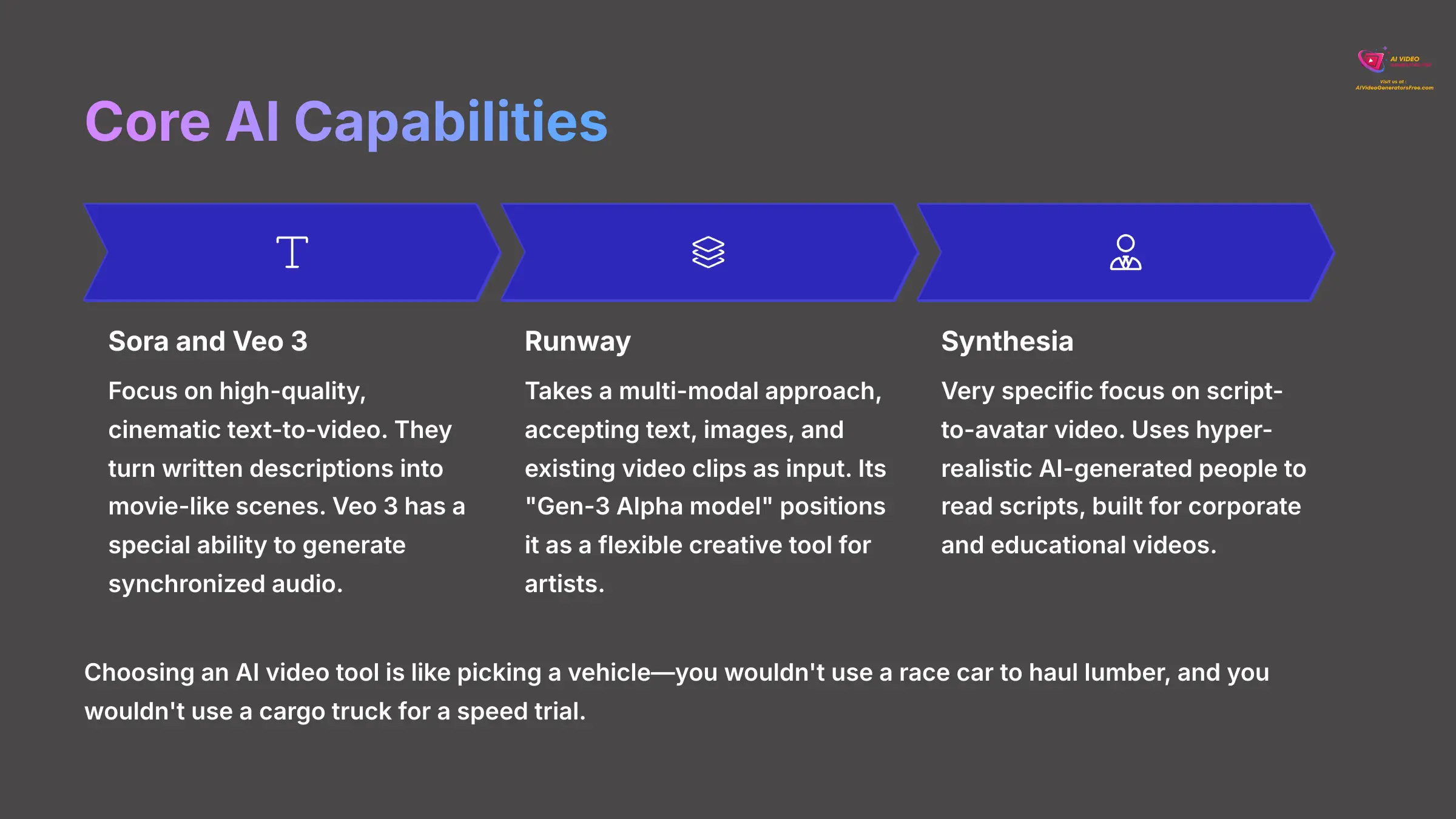

The fundamental AI model defines what a tool can create and from what type of input. Choosing an AI video tool is like picking a vehicle—you wouldn't use a race car to haul lumber, and you wouldn't use a cargo truck for a speed trial.
- Sora and Veo 3: These tools focus on producing high-quality, cinematic text-to-video. They turn your written descriptions into movie-like scenes. My tests show Veo 3 has a special ability to generate synchronized audio, which gives it an edge for creating more complete clips.
- Runway: This tool takes a multi-modal approach. That means it accepts text, images, and even existing video clips as input. Its “Gen-3 Alpha model” positions it as a flexible creative tool for artists who want to build upon existing media, not just generate from scratch.
- Synthesia: This generator has a very specific focus on script-to-avatar video. It uses hyper-realistic AI-generated people to read your scripts. This makes it a specialist tool, built for corporate and educational videos rather than artistic creation.
Output Quality: Resolution, Consistency, and Artifacts
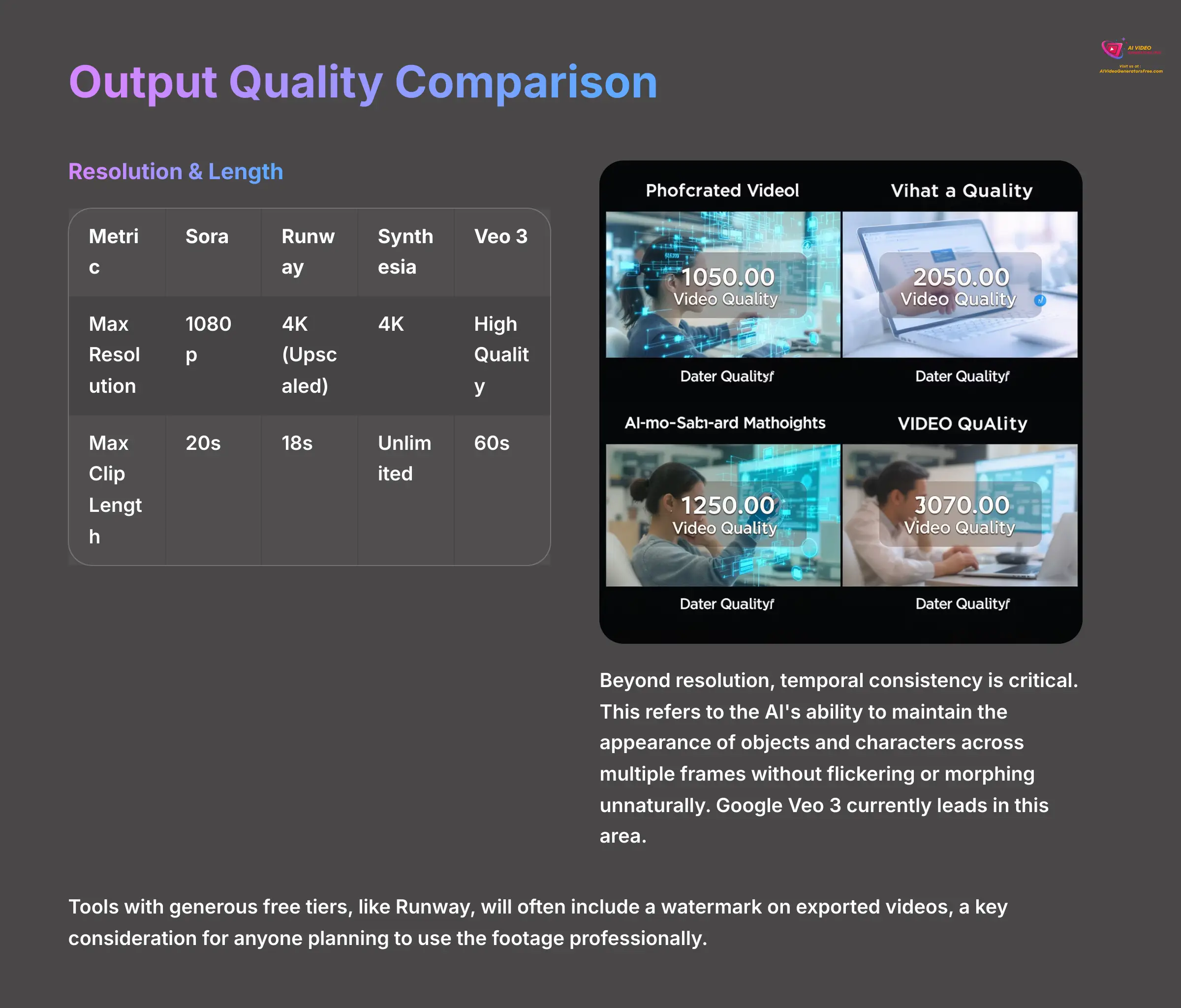

The final quality of the video is a major factor. In my testing, I look at everything from the raw resolution to how well the video holds together over time. Veo 3 and Sora are top performers for realism, but they achieve it in different ways.
Sora generates videos up to 20 seconds long in 1080p resolution, which delivers excellent quality for most professional uses. Runway's Standard plan allows users to upscale resolution in Gen-1 and Gen-2 models, enabling 4K exports through an intelligent upscaling process that enhances lower-resolution video using AI.
When I talk about consistency, I mean how well the AI keeps characters and objects looking the same throughout a clip. My analysis shows Veo 3 is the best at this for longer videos. Sora sometimes struggles with this, showing minor changes or artifacts in clips over 15 seconds long. An artifact is a visual glitch or error in the generated video.
Beyond resolution, temporal consistency is a critical factor I test. This refers to the AI's ability to maintain the appearance of objects and characters across multiple frames without them flickering or morphing unnaturally. My tests confirm that Google Veo 3 currently leads in this area, which is vital for producing believable, longer-form content. Conversely, tools with generous free tiers, like Runway, will often include a watermark on exported videos, a key consideration for anyone planning to use the footage professionally.
| Metric | Sora | Runway | Synthesia | Veo 3 |
|---|---|---|---|---|
| Max Resolution | 1080p | 4K (Upscaled) | 4K | High Quality |
| Max Clip Length | 20s | 18s | Unlimited | 60s |
User Experience: Interface, Workflow, and Control
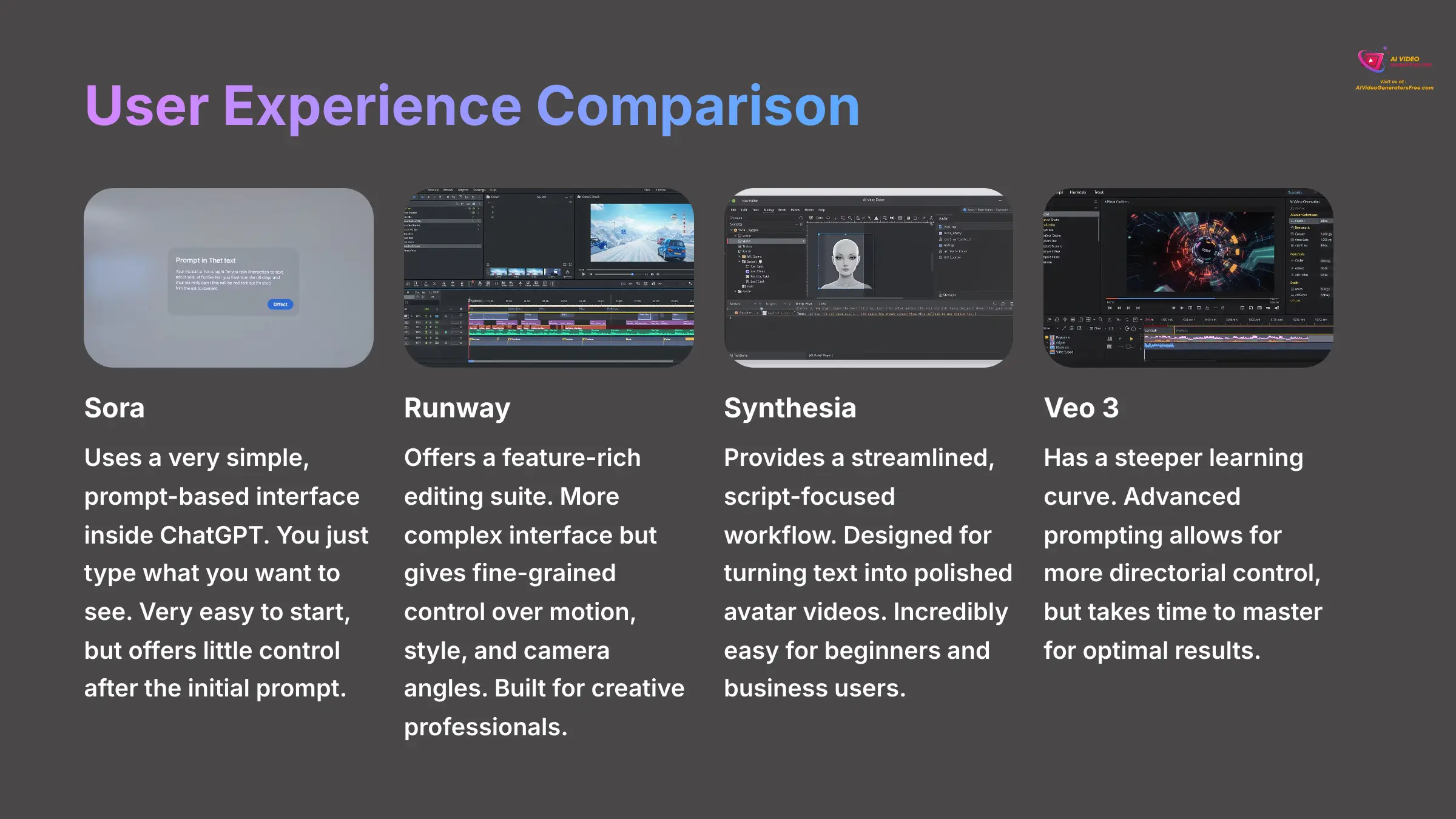

How a tool feels to use is just as important as its output. There's often a trade-off between simplicity and creative control. Using Sora is like giving a master painter a detailed description and getting a masterpiece back. Using Runway is like being handed the painter's entire studio of brushes, paints, and canvases to create the masterpiece yourself.
- Sora uses a very simple, prompt-based interface inside ChatGPT. You just type what you want to see. This makes it very easy to start, but it offers very little control after the initial prompt.
- Runway offers a feature-rich editing suite. The interface is more complex but gives you fine-grained control over motion, style, and camera angles. It's built for creative professionals who want to direct the AI.
- Synthesia provides a streamlined, script-focused workflow. It's designed for one job: turning text into a polished avatar video. This makes it incredibly easy for beginners and business users.
- Veo 3 has a steeper learning curve. Its advanced prompting allows for more directorial control, but it takes time to master.
Pricing and Value: Which Tool Offers the Best ROI?
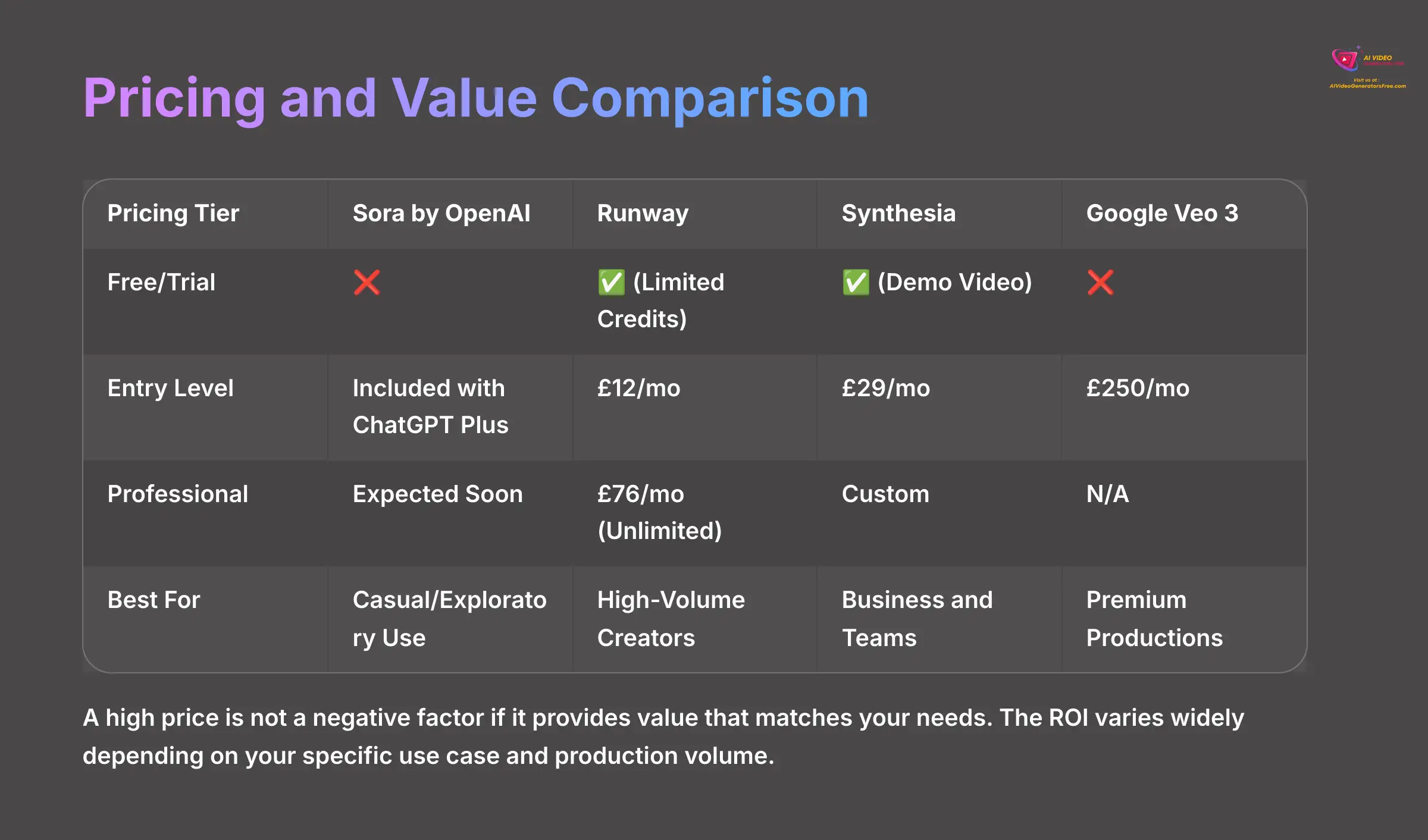

The price of these tools varies widely. I always analyze the return on investment (ROI) for different types of users. A high price is not a negative factor if it provides value that matches your needs. I've broken down the costs and what you get for your money.
| Pricing Tier | Sora by OpenAI | Runway | Synthesia | Google Veo 3 |
|---|---|---|---|---|
| Free/Trial | ❌ | ✅ (Limited Credits) | ✅ (Demo Video) | ❌ |
| Entry Level | Included with ChatGPT Plus | $12/mo | $29/mo | $250/mo |
| Professional | Expected Soon | $76/mo (Unlimited) | Custom | N/A |
| Best For | Casual/Exploratory Use | High-Volume Creators | Business and Teams | Premium Productions |
Deep Dive: Tool-by-Tool Strengths and Limitations
Here, I'll provide a more detailed profile for each tool. This is for those of you who already have a specific generator in mind and want to know more about its good and bad points. I've kept the structure consistent so you can still compare them easily.
Sora by OpenAI: The Cinematic Dream Machine


Sora is honestly an amazing tool for generating beautiful, movie-like scenes from text. It has a fantastic understanding of prompts and can produce some of the most compelling AI video I've ever seen. It's shockingly good at creating mood and atmosphere.
- Key Features: Its main features are cinematic text-to-video generation and a strong narrative understanding from complex prompts.
- Strengths: I found its greatest strengths are its unmatched cinematic quality from simple text and its highly accessible availability through ChatGPT Plus at no additional cost.
- Limitations: My tests revealed issues with character inconsistency. This means if you generate a 20-second clip of “a woman with a red scarf walking,” the pattern on her scarf or the style of her hair might subtly change at the 15-second mark. For short B-roll this is often acceptable, but it's a major hurdle for narrative storytelling. It has no editing controls at all, and the short clip length (20s) is a big drawback for professional use.
- Best For: Sora is best for pre-visualization for films, creating ad concepts, and generating high-quality B-roll footage. A user told me, “Sora is like having a dream-machine for visuals, but you have to be willing to sift through some nightmares to find the gems.”
Runway: The All-in-One Creative Suite
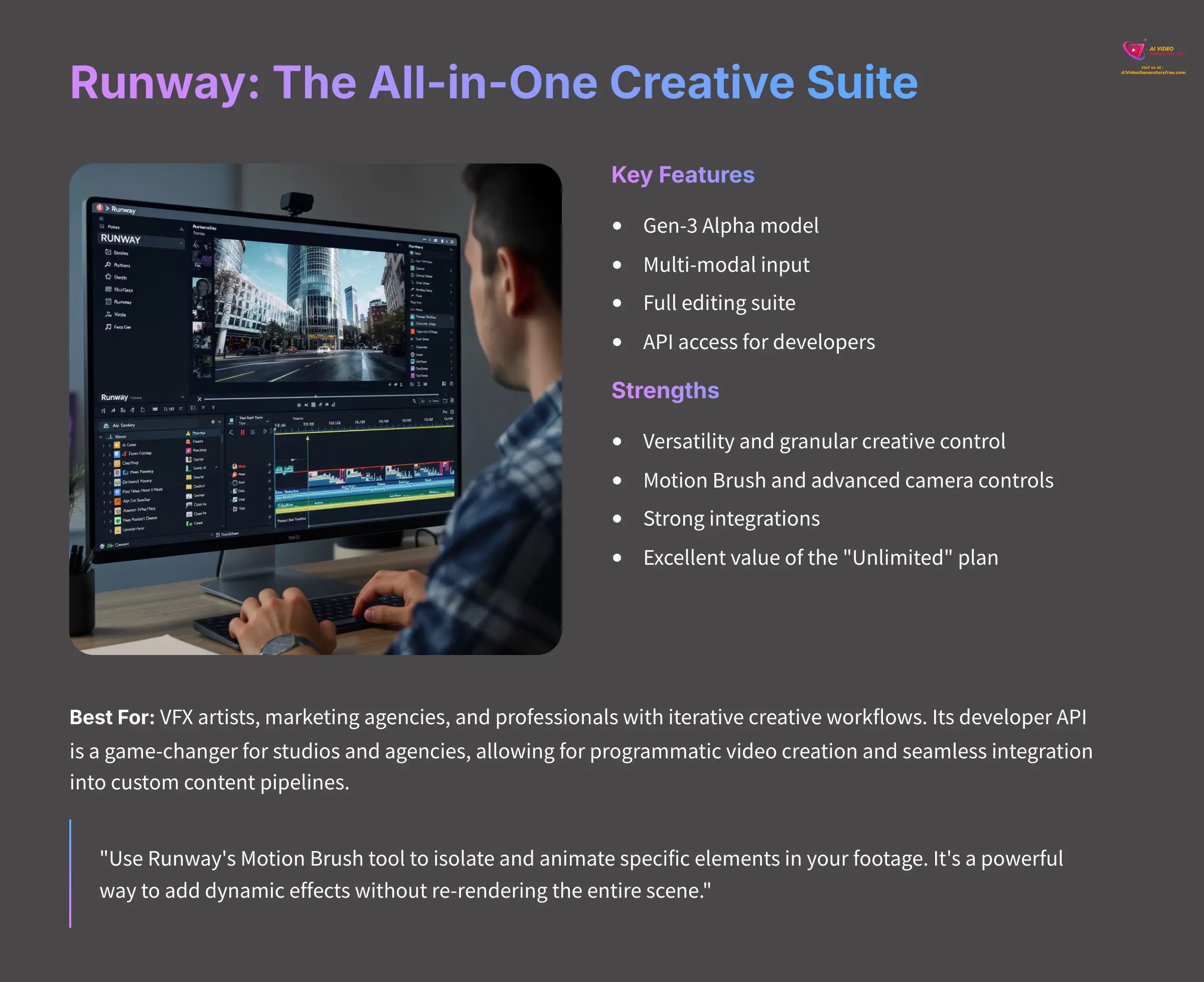

Runway is the workhorse of the AI video world. It's not just a generator; it's a complete toolkit for creative professionals. Its versatility is its greatest asset, allowing you to edit, composite, and generate video in one place.
- Key Features: Standout features include the Gen-3 Alpha model, multi-modal input, a full editing suite, and API access for developers.
- Strengths: Its main strengths are its versatility and the granular creative control it offers, including tools like Motion Brush and advanced camera controls. Its strong integrations and the excellent value of the “Unlimited” plan make it a top choice for serious creators. For studios and agencies, its developer API is a game-changer, allowing for programmatic video creation and seamless integration into custom content pipelines.
- Limitations: The one area it falls short is that its cinematic quality is still a small step behind what Sora and Veo 3 can produce.
- Best For: Runway is ideal for VFX artists, marketing agencies, and any professional with an iterative creative workflow. For example, a creative team could upload a client's product image (Image-to-Video), generate a short scene, use the Motion Brush tool to animate just the logo, and then use the in-app editor to add text overlays. This entire iterative process happens in one place, which is Runway's biggest advantage. A pro tip from my experience: “Use Runway's Motion Brush tool to isolate and animate specific elements in your footage. It's a powerful way to add dynamic effects without re-rendering the entire scene.”
Synthesia: The Corporate Video Powerhouse
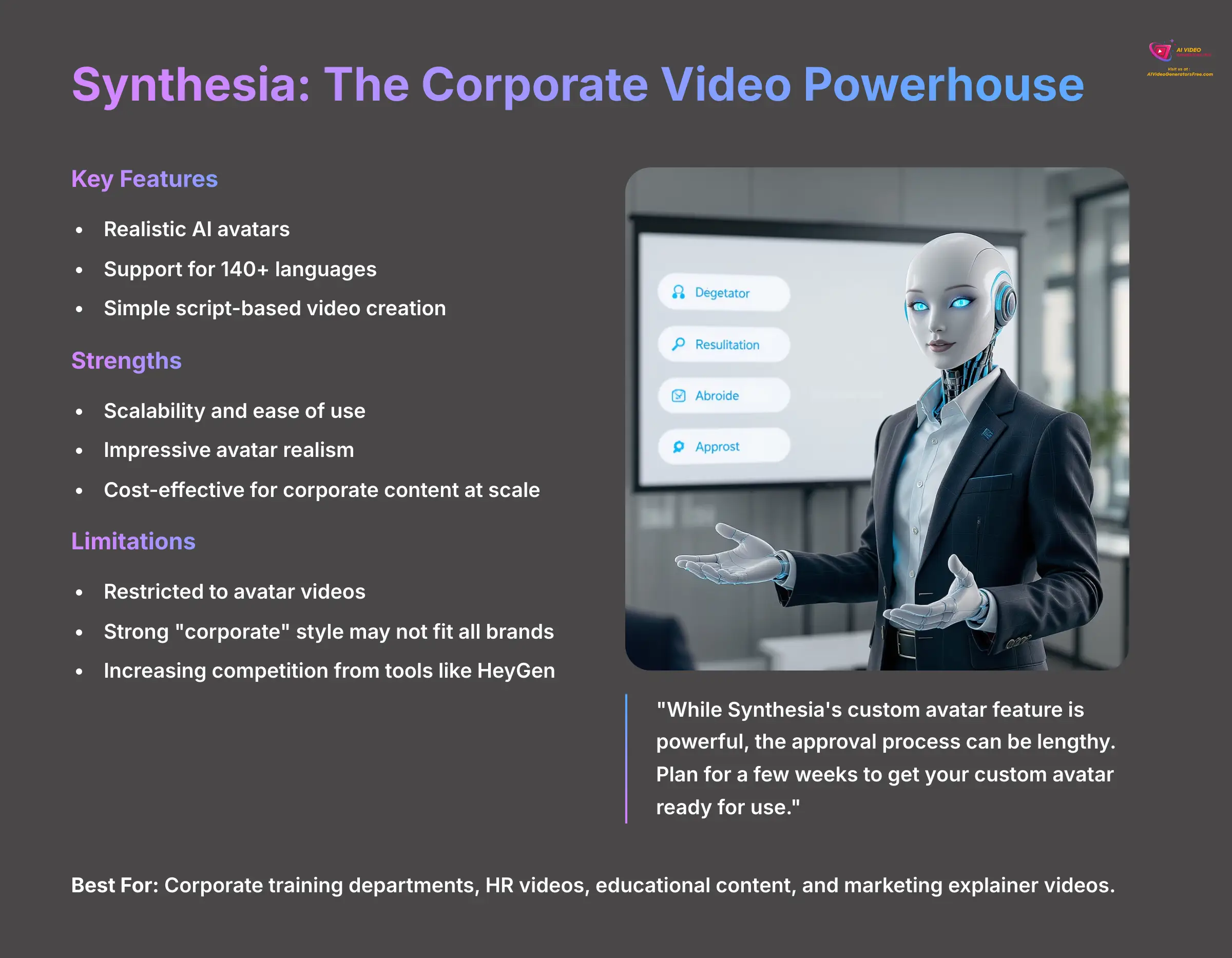

Synthesia is a specialist, and it is the absolute best at what it does. It produces polished, professional videos featuring AI avatars that can speak in over 140 languages. Synthesia is the ultimate assembly line for corporate video. You input the script blueprint, and it produces perfectly uniform, multilingual video spokespeople.
- Key Features: Its top features are its realistic AI avatars, support for 140+ languages, and simple script-based video creation.
- Strengths: Synthesia's biggest benefits are its scalability and ease of use. The realism of its avatars is impressive, and it's extremely cost-effective for creating corporate content at scale.
- Limitations: Its use is restricted to avatar videos. The strong “corporate” style may not be a good fit for all brands or creative projects. Furthermore, the AI avatar space is becoming more competitive. Tools like HeyGen offer strong competition with features like instant avatar creation and voice cloning from a short audio sample, which can be faster for certain use cases, though Synthesia maintains an edge in enterprise-level security and support.
- Best For: I recommend Synthesia for corporate training departments, HR videos, educational content, and marketing explainer videos. A note of caution: “While Synthesia's custom avatar feature is powerful, the approval process can be lengthy. Plan for a few weeks to get your custom avatar ready for use.”
Google Veo 3: The Premium Quality Leader
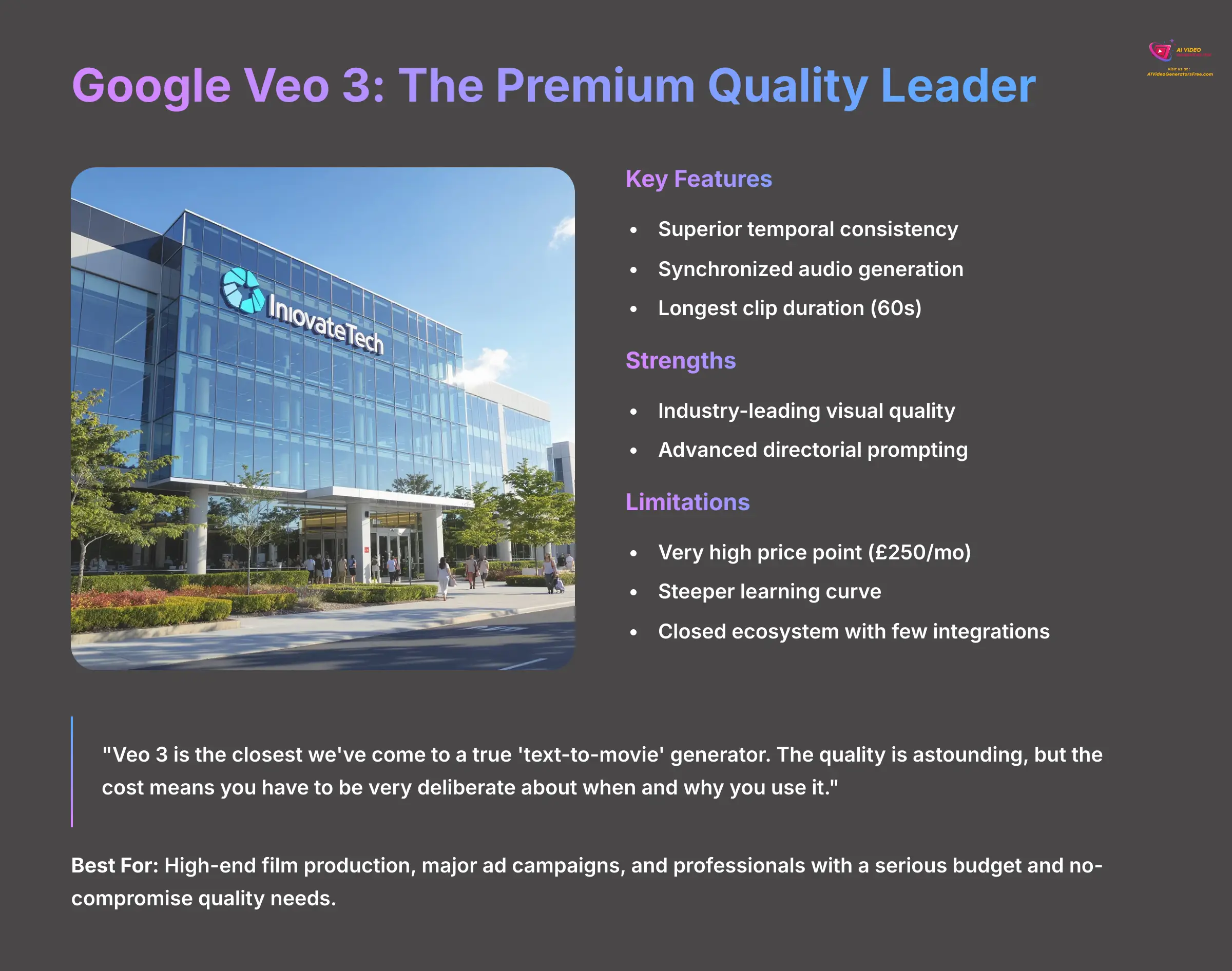

Veo 3 is the new benchmark for pure visual quality in AI video. It produces stunningly realistic and consistent video clips that are longer than any competitor's. It's a premium tool for users who cannot compromise on quality.
- Key Features: Its headline features are superior temporal consistency (meaning it keeps things stable over time), and synchronized audio generation.
- Strengths: The visual quality is industry-leading. Its advanced directorial prompting and the longest clip duration (60s) make it a powerful tool for serious productions.
- Limitations: The main drawback is the very high price point ($250/mo). It also has a steeper learning curve and operates in a closed ecosystem with few integrations.
- Best For: Veo 3 is built for high-end film production, major ad campaigns, and professionals with a serious budget and no-compromise quality needs. As one filmmaker put it, “Veo 3 is the closest we've come to a true ‘text-to-movie' generator. The quality is astounding, but the cost means you have to be very deliberate about when and why you use it.”
Frequently Asked Questions About Deevid AI Alternatives
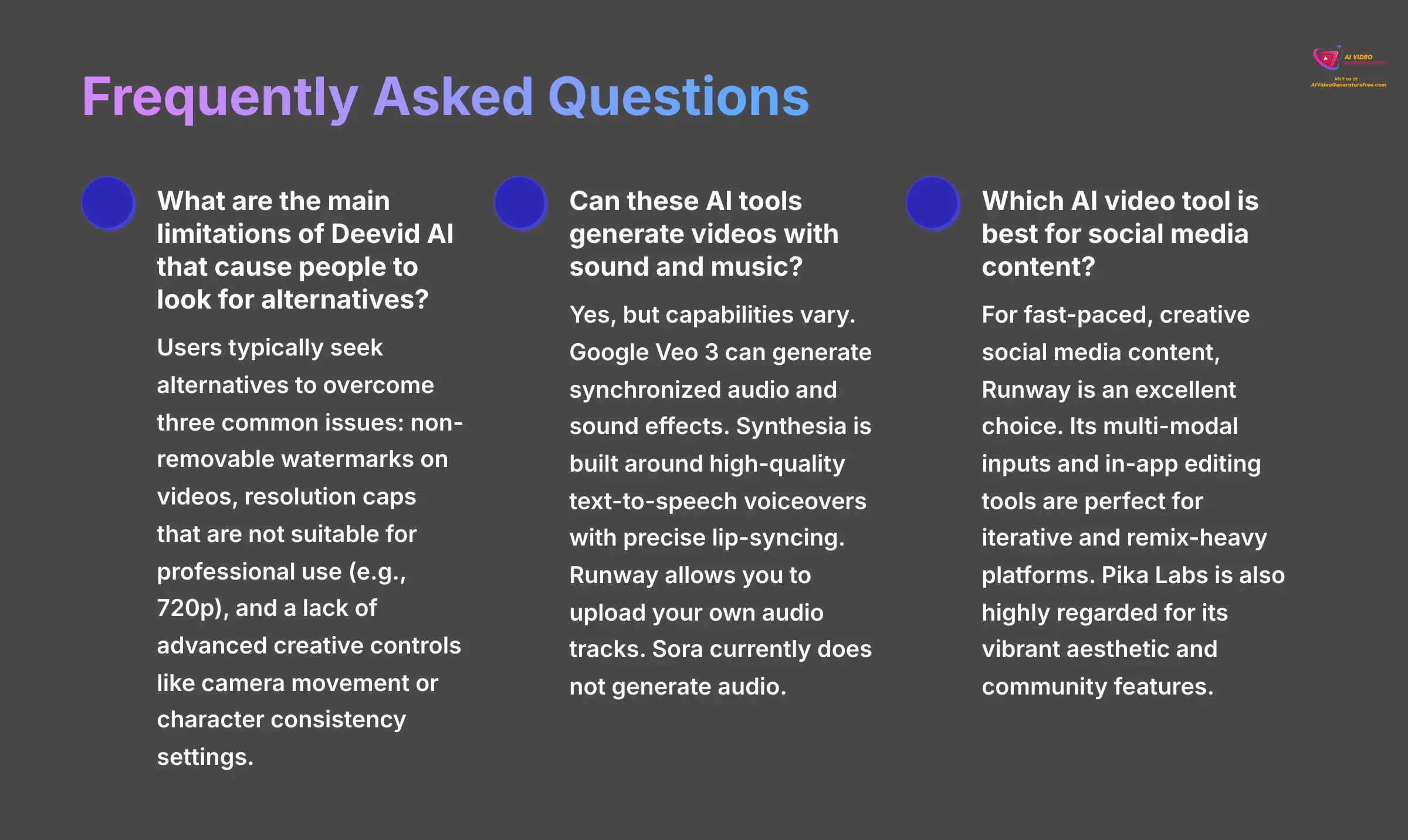

1. What are the main limitations of Deevid AI that cause people to look for alternatives?
Users typically seek alternatives to Deevid AI to overcome three common issues: non-removable watermarks on videos, resolution caps that are not suitable for professional use (e.g., 720p), and a lack of advanced creative controls like camera movement or character consistency settings.
2. Can these AI tools generate videos with sound and music?
Yes, but capabilities vary. Google Veo 3 can generate synchronized audio and sound effects that match the video content. Synthesia is built around high-quality text-to-speech voiceovers with precise lip-syncing. Runway allows you to upload your own audio tracks and is developing its own sound generation features. Sora currently does not generate audio.
3. Which AI video tool is best for social media content like TikToks or Reels?
For fast-paced, creative social media content, Runway is an excellent choice. Its multi-modal inputs (image-to-video, video-to-video) and in-app editing tools are perfect for the iterative and remix-heavy culture of these platforms. Its competitor, Pika Labs, is also highly regarded in this space for its vibrant aesthetic and strong community features.
4. Is there a free alternative to Deevid AI without a watermark?
Finding a high-quality AI video generator that is completely free and has no watermark is extremely rare. Most tools, like Runway, offer a free trial with limited credits, but exported videos will have a watermark. The best approach is often to start with a low-cost entry plan, such as Sora's access via ChatGPT Plus, to get professional, watermark-free results on a budget.
Decision Framework: Which AI Video Tool Is Right for You?
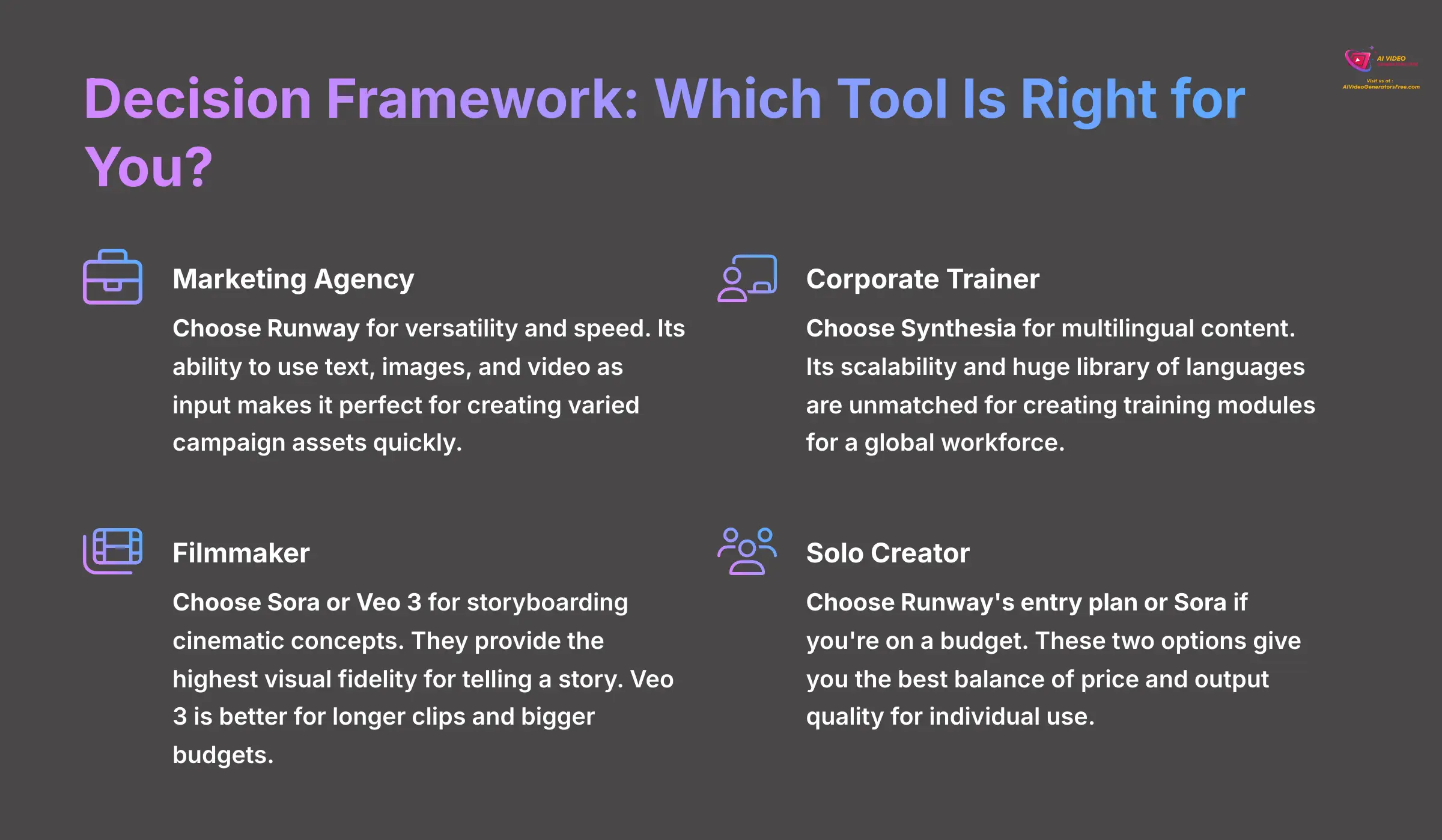

To make this simple, I've mapped the best tool to specific professional roles. Find your job title below to see my direct recommendation based on my extensive testing.
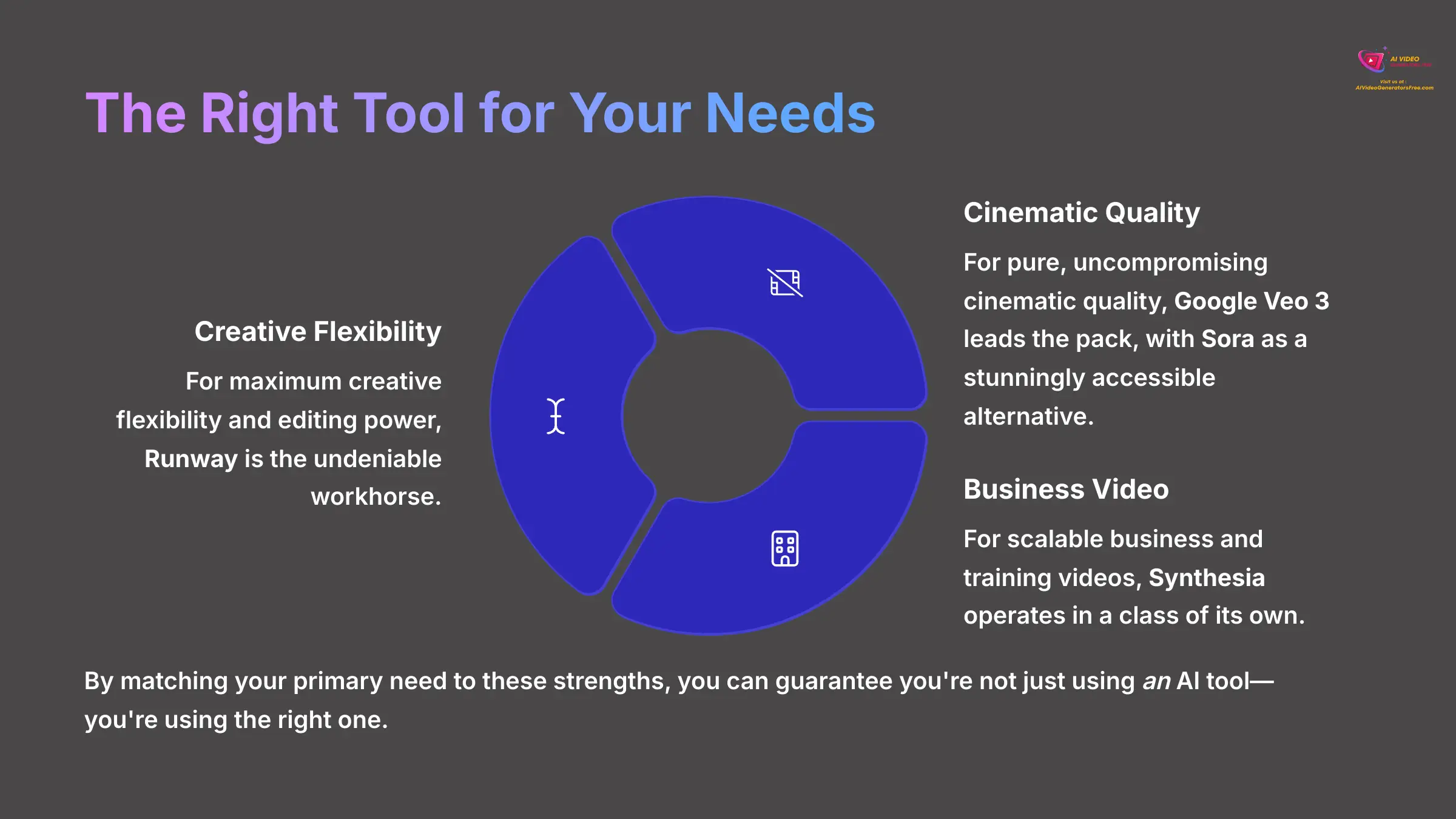

- If you're a Marketing Agency needing versatility and speed, choose Runway. Its ability to use text, images, and video as input makes it perfect for creating varied campaign assets quickly.
- If you're a Corporate Trainer creating multilingual content, choose Synthesia. Its scalability and huge library of languages are unmatched for creating training modules for a global workforce.
- If you're a Filmmaker storyboarding a cinematic concept, choose Sora or Veo 3. They provide the highest visual fidelity for telling a story and selling a creative vision. Veo 3 is better if you need longer clips and a bigger budget.
- If you're a Solo Creator on a budget, choose Runway's entry plan or Sora. These two options give you the best balance of price and output quality for individual use.
Final Verdict and Recommendations
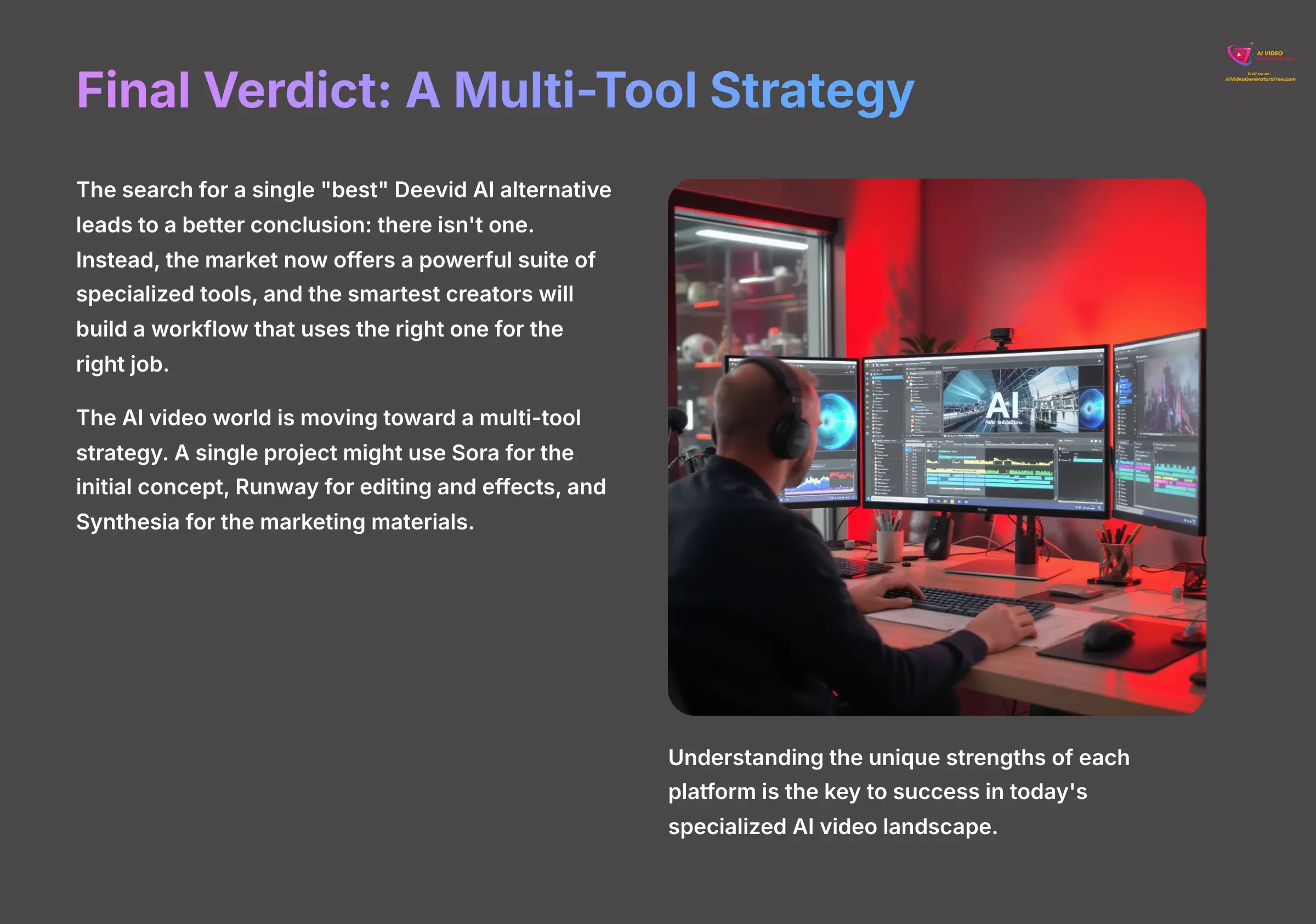

So, the search for a single “best” Deevid AI alternative leads to a better conclusion: there isn't one. Instead, the market now offers a powerful suite of specialized tools, and the smartest creators will build a workflow that uses the right one for the right job.
The AI video world is moving toward a multi-tool strategy. A single project might use Sora for the initial concept, Runway for editing and effects, and Synthesia for the marketing materials. Understanding the unique strengths of each platform is the key to success.
Your choice is now clear. For maximum creative flexibility and editing power, Runway is the undeniable workhorse. For pure, uncompromising cinematic quality, Google Veo 3 leads the pack, with Sora as a stunningly accessible alternative. And for scalable business and training videos, Synthesia operates in a class of its own. By matching your primary need to these strengths, you can guarantee you're not just using an AI tool—you're using the right one.
Disclaimer: The information about the best Deevid AI alternatives presented in this article reflects our thorough analysis as of 2025. Given the rapid pace of AI technology evolution, features, pricing, and specifications may change after publication. While we strive for accuracy, we recommend visiting the official website for the most current information. Our overview is designed to provide a comprehensive understanding of each tool's capabilities rather than real-time updates.
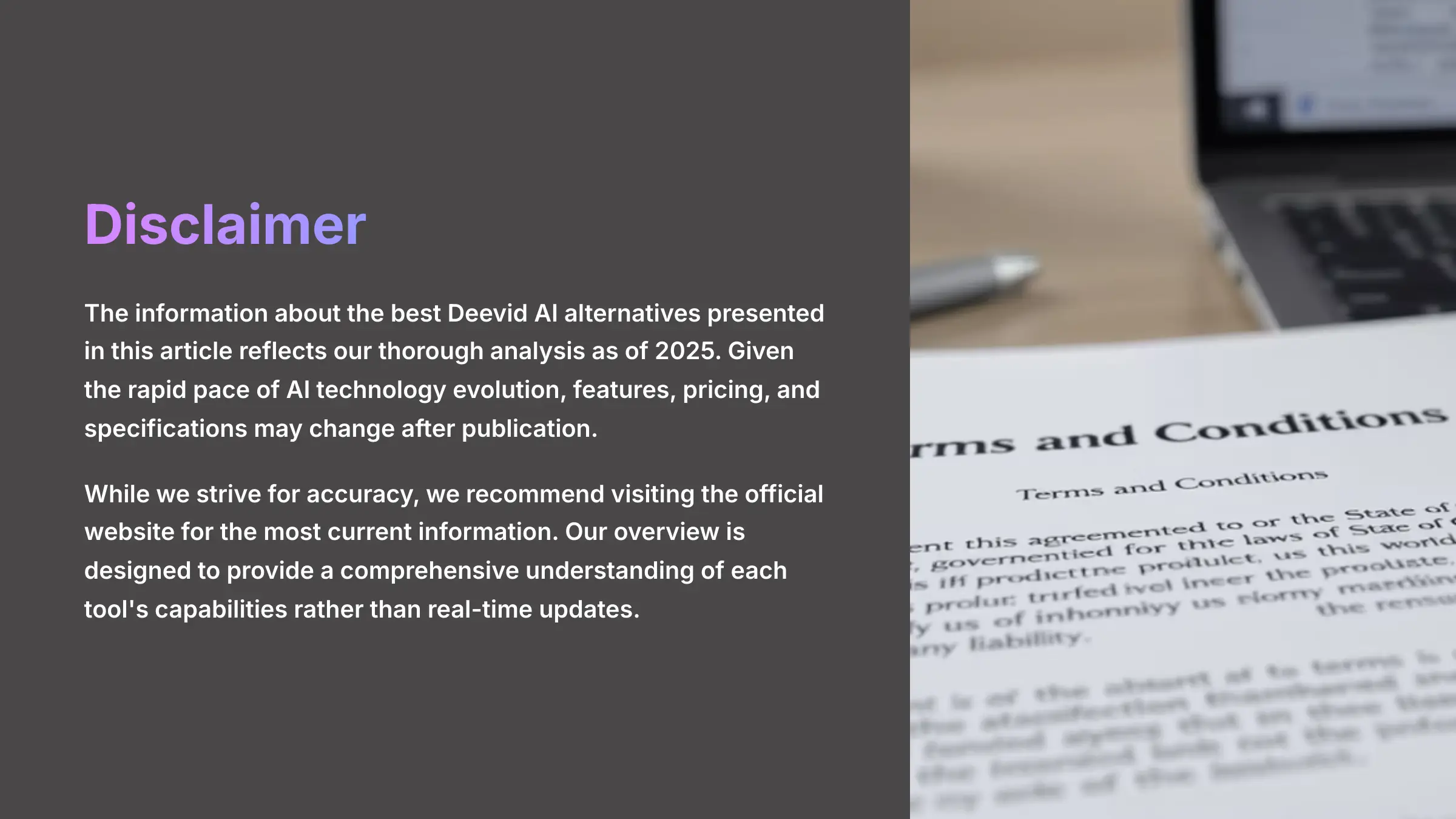

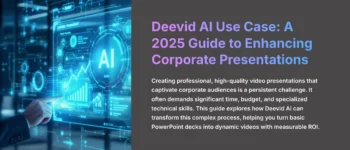
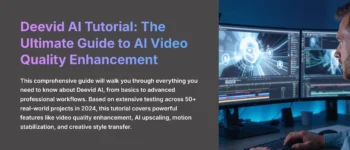
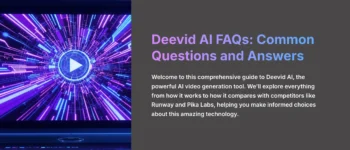
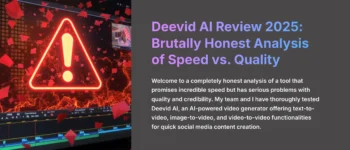
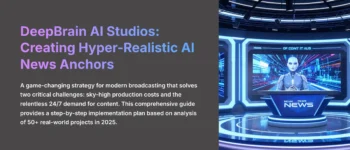
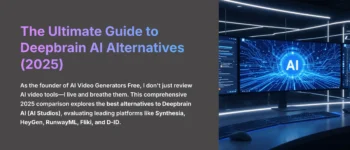

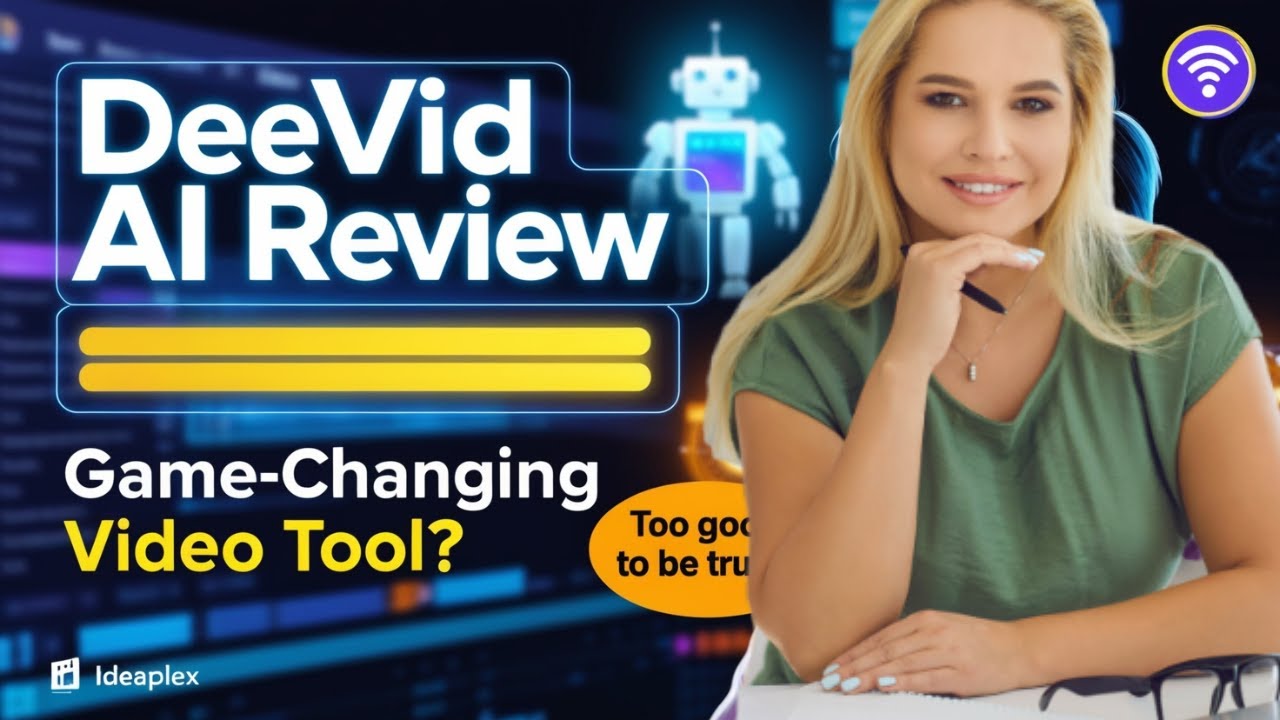

Leave a Reply